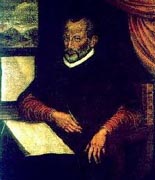
Recommended Cd's
For the first half of the sixteenth century it was the composers of the Netherlands that lead the way in the development of the mass. As the century drew to a close Italian musicians began absorbing the techniques of the north. The reformation caused large areas of the church's former domain to be cut off. England had broken from the church under Henry VIII and in Germany; Lutheranism had forced many composers to declare their religion. The availability of talent for mass composition was therefore depleted to a considerable degree. The church's response to this chain of events was to clamp down on the contents of the mass. Composers were forbidden to use any profane material (i.e. popular songs) as the basis for their compositions. The intelligibility of the words for the mass became a top priority. Both of these restrictions ran counter to the compositional techniques now prominent in the north.
From this turmoil sprang one of the most influential composers of the century, Giovanni Palestrina (1525-1594). His most famous mass 'Missa Papae Marcelli' is said to conform to these new standards set down by the church. Palestrina relied heavily upon plainchant for his mass music, while ignoring much that had taken place in the north. He saw his task as bringing the old cantus firmus and plainchant up to the same high level of complexity as had been achieved by the composers of the imitation mass. His style is highly refined and dense. By the beginning of the seventeenth century the best composers were all working in Italy and opera was becoming increasingly more popular. The church's demands made during the Counter Reformation proved counter productive. It was far more important to the church to have the people come to hear great musicthen it was to have the music convey the message of god. Composers turned from complexity to drama in both their sacred and the secular compositions. The counter reformation called for both brevity and clarity in musical, and the progressive composers of the north produced works of vast complexity but it was ultimately the drama and passion of music that trumped them both and brought an end to the Renaissance.